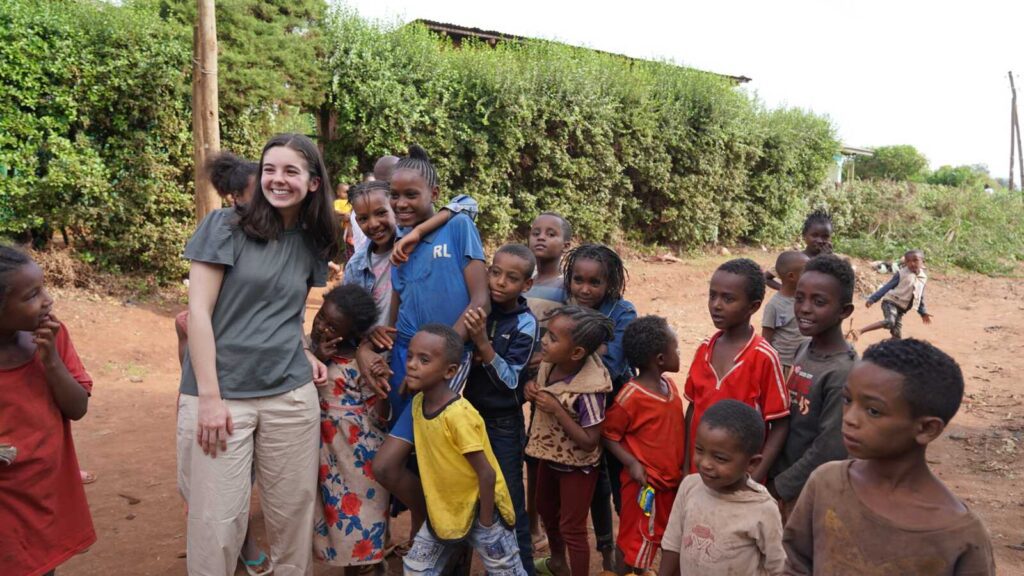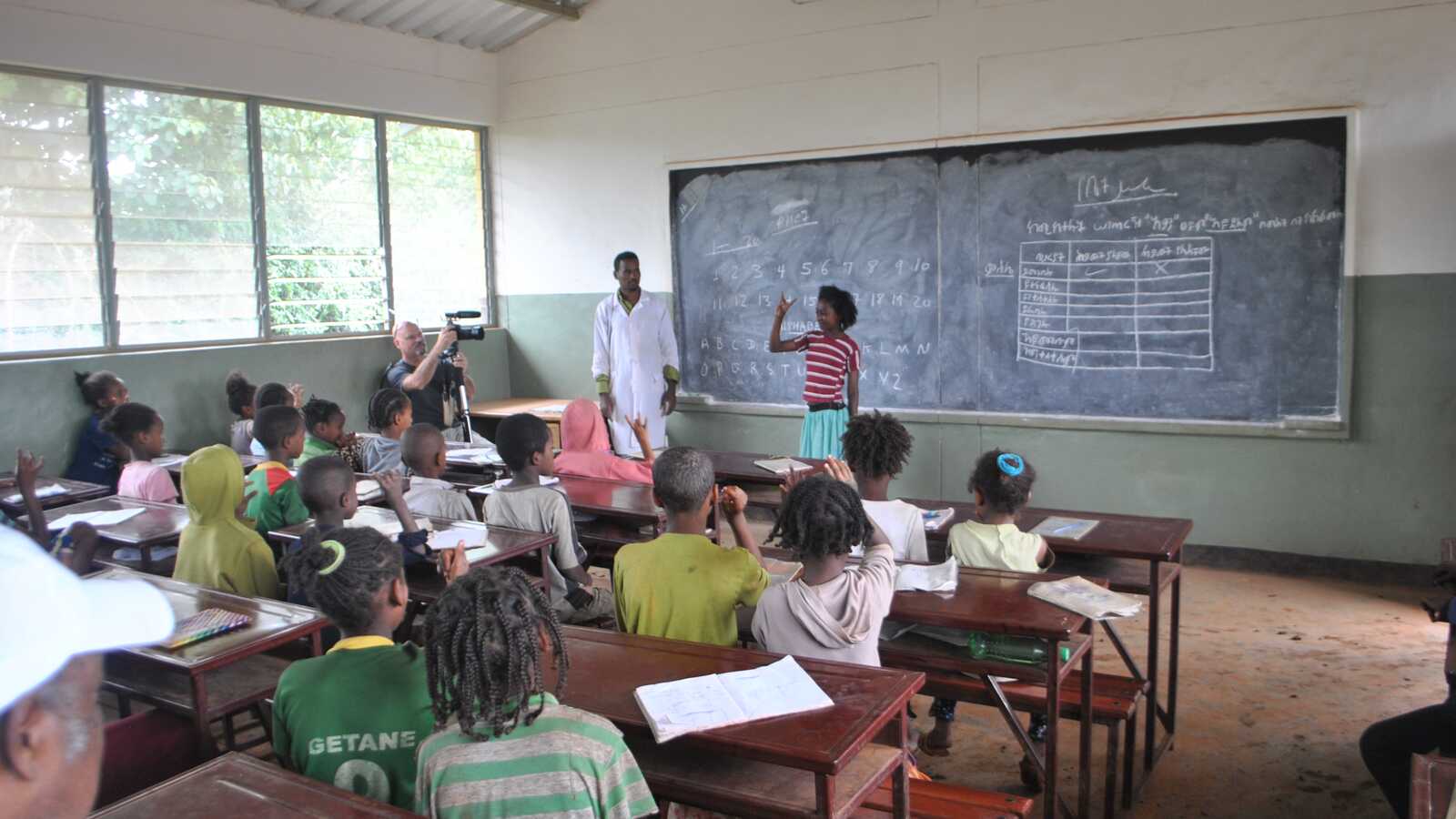Severely malnourished, Marya and her brother spent months in Holt’s malnutrition rehabilitation unit in Ethiopia. Today, they’re back home — healthy and smiling again.

When 5-year-old Marya first came to the hospital, she was more than hungry — she was dangerously malnourished.
Her tummy, hands and feet were swollen. She was weak and tired, and had constant infections that wouldn’t clear up. Her 7-year-old brother, Abai, was in the same condition. And it was all because of a lack of food…
Their parents did all they could to provide for all five of their children, but at a certain point, a malnourished child can become too ill to even feel hungry or eat. That’s when their parents knew they needed help. So they scooped up Marya and Abai and walked from their village to Holt’s Mother and Child Hospital in Shinshicho, Ethiopia.
When they got there, the children were rushed down to the lower level of the hospital, and back to Holt’s malnutrition rehabilitation unit.
A Rise in Childhood Hunger
Right now, around the world, more children than ever are going hungry. Food prices continue to soar after the pandemic, and poverty is at an all-time high. In Ethiopia, widespread drought and internal conflict add to the lack of food security. Not only are children getting dangerously thin and sick, but even their long-term growth is being stunted.
But the good news is these children can be treated — and their stunted growth reversed.

Julia Hayes is Holt’s manager of nutrition and health services. Last summer, she traveled to Ethiopia to visit children in Holt’s nutrition programs.
“Nutrition is so important to be able to provide that catch-up growth to get them on a level where they can thrive into adolescence,” Julia says, “and eventually into adulthood.”
Helping Children & Families Overcome Hunger
That’s why Holt’s donor-supported food programs are more important than ever — and beyond simply giving food to hungry children, many of these programs get to the root causes of hunger for families around the world.

Holt goes out into local communities to hold nutrition screenings and nutrition classes for parents. Struggling families receive livestock such as chickens, a goat or a cow — which then provide vital daily protein and nutrients to growing kids. Parents learn how to grow gardens, either in extra plots of land near their homes or even in “kitchen gardens” using waste water from their kitchens to grow little household gardens. Across Holt-supported orphanages and schools, children receive nutritious daily meals.
These initiatives are sustainable solutions to help fill children’s empty bellies in the long-term. But for children who have already gone without food for a long time, the response is more critical.
Helping Malnourished Children in Ethiopia
Children in Ethiopia are often first identified as malnourished by Holt Ethiopia health extension workers — trained health professionals who are also trusted members of the community. And the earlier they identify malnutrition, the less impact there is to a child’s development.
“This is a big way Holt Ethiopia makes sure that we are reaching the communities that we’re serving,” says Julia. “We’re not just putting up a health post and expecting people to come to us. [These health extension workers] know the families and communities best and are really the heart of the work.”

So when a health extension worker comes across a child who is severely malnourished, they often refer them directly to the malnutrition rehabilitation unit at Holt Ethiopia’s Mother and Child Hospital.
Holt’s Nutrition Treatment Center
This unit at the hospital is composed of several rooms: an entry and meeting room, a recreation room of toys for the children, and then two in-patient rooms with two beds each. One room is for children with more mild cases of malnutrition, and the second room is for the more critical cases. This second room is where Marya and Abai received the lifesaving nutrition care they needed once admitted.
In the rehab unit, they first received a specialized low-protein, milk-based formula to help them stabilize. Then, they gradually transitioned to a second specialized formula with higher protein and energy content, before finally graduating back onto solid food. Their treatment took months, as the medical staff were careful not to overwhelm their fragile bodies.
But even after just a few weeks, Marya and Abai began to get their energy back — and they noticed all the toys and activities in the room next to them.

“The play and interactive materials are so that the children can play, engage and get rid of depression while staying at the center,” says Selamawit Girma, a Holt Ethiopia social worker. “The opportunity also helps caregivers open their eyes about how to stimulate their children at home through play, in addition to the nutrition services.”
Marya and Abai’s parents stayed with them at the hospital during their recovery — switching off between being with with Marya and Abai, and their other three children at home. And during that time, Holt helped provide them and other parents staying at the hospital with nutritious food so they could feed themselves while they were there as well.
“It would be very difficult, if not impossible, for our children to be alive today without the treatments they have received.”
“It would be impossible for us to stay and treat our children at the hospital for those months, had it not been for something we could eat while staying there,” Marya and Abai’s parents said.
Recovering at Home
While the children’s time there was long, it was exactly the critical and careful care they needed to recover. And today, Marya and Abai are reunited with their siblings at home, where they are healthy and have the energy once again to play and go to school! For their parents, the gravity of their situation is not lost, and they’re so thankful for the care they received.
“It would be very difficult,” they said, “if not impossible, for our children to be alive today without the treatments they have received.”
Marya and Abai, like all children who spend time at the malnutrition rehabilitation unit, have had several follow-up visits from Holt health workers at their home to check on their growth and nutritional status, as well as to provide any other needed support to the family.
“There’s a community connection for those treated at the hospital,” says Julia. “Holt isn’t just there in the hospital, but we provide follow-up and assessment in the home setting.”
Follow-Up Care at Home

At these home visits, Holt Ethiopia health extension workers identify any risk factors within the home — anything from what and how much a child is fed, to how the food is stored or prepared. Holt Ethiopia also uses a story-based flipbook to help educate families about healthy foods, how to prepare them, and how to increase their access to food through gardening or raising livestock.
While these home visits can be a vulnerable experience for the families, it’s so helpful for the health extension workers to gather more insight into the family’s health and nutrition and to develop strong relationships with the families they support. And because they care so much about their children, families welcome these visits as well.
“We are grateful that we’re able to provide what we can to get them back on their feet,” says Julia, “and educate in the long-term to keep them from ever having to return to the hospital.”
While Marya and Abai have now been out of the hospital for several months, they’ll continue to be monitored during these home visits to ensure they continue to grow and remain healthy. More than anything, their parents are so grateful to have them back home — where they’re smiling and thriving within their care.

Feed a Hungry Child
Your gift can save a child from another week of hunger.




